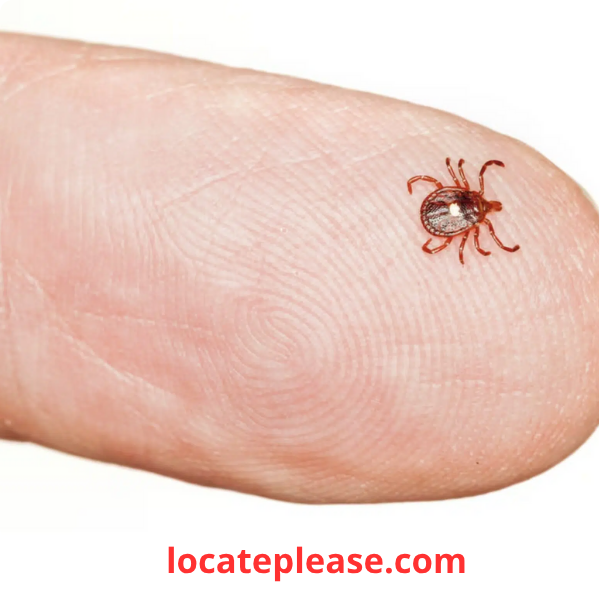It was a quiet Saturday afternoon. The sun hung high, birds chirped, and my golden retriever, Mochi, lay sprawled under our old oak tree like a furry king basking in his domain. I was in the backyard, wrestling with my ancient, sputtering lawnmower — a machine that groans louder than I do after leg day.
Everything felt peaceful. Normal. Until it wasn’t.
I felt it first as a faint itch on my ankle — not painful, not sharp, just… off . Like a tiny feather brushing against my skin. My first thought? Mosquito. No big deal. I’ve battled plenty of those. But when I glanced down, my blood ran cold.
There it was.
A small, dark speck clinging to my skin. Not moving. Not buzzing away. Just… there . And worse — it was buried in .
Without thinking, I reached down and plucked it off. That’s when I saw it clearly: a tick , unmistakable in its horror. And not just any tick — it had a single, ghostly white dot on its back.
The dreaded Lone Star Tick .
What Is the Lone Star Tick? Meet Nature’s Stealth Predator
If you’ve never heard of the Lone Star tick (Amblyomma americanum ), consider yourself lucky. Named for the distinctive white spot on the female’s back (the only “cute” thing about it), this tick is far from your average backyard nuisance.
Unlike most ticks that passively wait on blades of grass for a host to brush by, the Lone Star tick is an active hunter . Yes — it seeks you out . It can sense your breath, your body heat, even the carbon dioxide you exhale… and then it moves toward you . Some experts say they can travel several feet across lawns or leaf litter just to find a warm-blooded meal.
And trust me — knowing that something so small can stalk you is enough to make your skin crawl. (Literally and figuratively.)
Why This Tick Is More Than Just Gross
Sure, ticks are universally disgusting. But the Lone Star tick isn’t just creepy — it’s dangerous .
This little monster can transmit several serious illnesses, including:
- Lyme-like illness (though not Lyme disease itself)
- Southern Tick-Associated Rash Illness (STARI) – causes a bullseye rash similar to Lyme
- Ehrlichiosis – flu-like symptoms that can become severe if untreated
- Tularemia – rare but potentially life-threatening
- Alpha-gal syndrome – yes, really. This one turns you allergic to red meat
That’s right. One bite from a Lone Star tick could mean you’ll never enjoy a steak, burger, or bacon-wrapped jalapeño again — at least without facing hives, nausea, or even anaphylaxis hours later.
Just writing this makes me want to burn all my hiking boots.
My Panic Was Real (And Totally Understandable)
Let’s be honest: I lost it.
I screamed. I cried. I may have done a frantic little dance while flinging the tick into the void beyond the fence. (RIP, evil speck.)
I’ve always prided myself on being tough — mosquito bites? Ice and lotion. Bee sting? Shrugs and ibuprofen. But ticks? They trigger something primal in me. It’s not just the itch, it’s the invasion. The idea that something has been feeding on my blood , unseen, for who knows how long?
Nope. Nope. Nope.
But here’s the thing I learned too late: Panic doesn’t help. Action does.
How to Remove a Tick Safely (So You Don’t Make It Worse)
If you ever find a tick attached to your skin — especially a Lone Star tick — here’s what you should do:
✅ 1. Stay Calm (Easier said than done, I know)
Panicking increases your heart rate, which might help pathogens spread faster. Take a deep breath. You’ve got this.
✅ 2. Use Fine-Tipped Tweezers
Grab the tick as close to the skin’s surface as possible.
✅ 3. Pull Upward with Steady, Even Pressure
Do not twist, jerk, or squeeze the tick. Yanking can leave its mouthparts embedded, increasing infection risk.
✅ 4. Clean the Area Thoroughly
Wash with soap and water or rubbing alcohol .
✅ 5. Dispose of the Tick Properly
- Do NOT crush it with your fingers (seriously — ew).
- Instead, drop it in alcohol, seal it in a bag, or flush it.
- Consider saving it in a labeled container in case you develop symptoms later.
After the Bite: What to Watch For
Even after removal, your job isn’t over. Monitor the bite site and your health for the next few weeks.
Seek medical attention if you experience:
- A bullseye-shaped rash or expanding red area around the bite
- Fever, chills, fatigue, or muscle aches
- Headaches or joint pain
- Delayed allergic reaction to red meat (tingling mouth, hives, stomach issues 3–6 hours after eating beef, pork, or lamb)
Early treatment with antibiotics can prevent complications — so don’t brush off symptoms as “just a bug bite.”
How to Protect Yourself (and Your Pets)
Since my encounter, I’ve become borderline obsessive about prevention. Here’s what works:
- Wear long pants and closed-toe shoes in wooded or grassy areas
- Use EPA-approved repellents with DEET, picaridin, or permethrin (on clothing)
- Treat your yard — keep grass short, remove leaf litter, use tick control sprays
- Check yourself, your kids, and your pets daily — especially after outdoor time
- Bathe or shower within two hours of coming indoors — helps wash off unattached ticks
And poor Mochi? He now wears a veterinarian-recommended tick collar and gets monthly preventatives. No more tick-pulling marathons for me, thank you very much.
Final Thoughts: Respect the Tick
That sunny afternoon in my backyard taught me a hard lesson: nature isn’t always peaceful. Sometimes, it sends tiny, blood-sucking ninjas to remind us to pay attention.
The Lone Star tick may be small, but its impact is huge. It’s not just gross — it’s a real health threat hiding in plain sight.
So the next time you’re enjoying the great outdoors — gardening, hiking, or just chasing your dog around the yard — take a moment to protect yourself.
Because no steak, no sunset stroll, and definitely no broken-down lawnmower is worth ending up with a tick-borne illness.
Stay vigilant. Stay protected. And for the love of all things holy — check your ankles.










